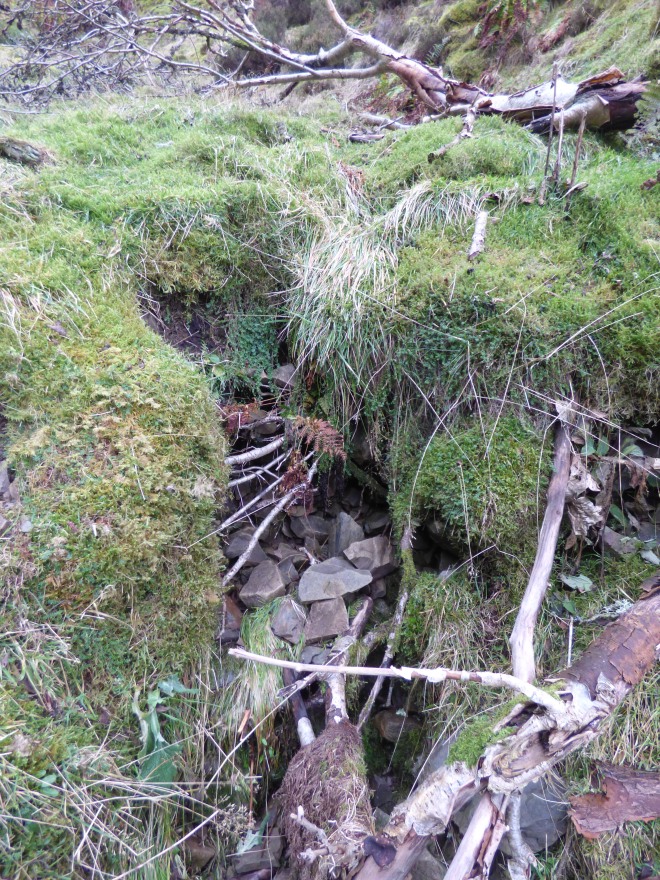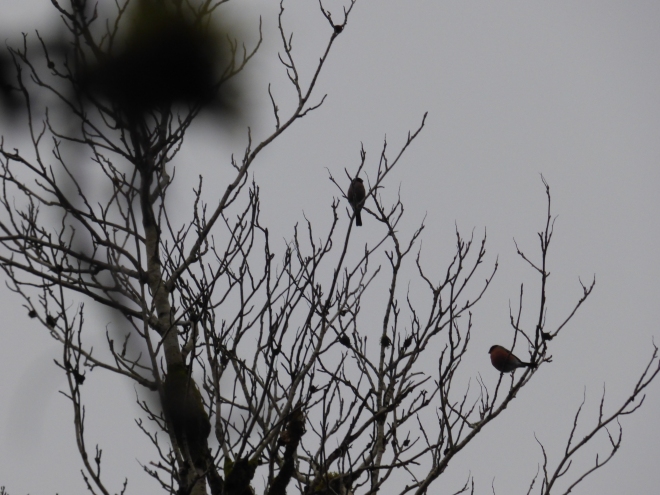All sounds more spectacular than it was.
Rough Moss Cleuch is a small valley/ravine in the Moorfoot Hills in the Scottish Borders, on the B709. I found out about it after mentioning on the Rewilding Scotland group that I was going to go and look at relict woodland in the Moorfoot Hills. Stuart Adair kindly sent me a report that detailed vegetation in selected cleuchs in the western Borders. (see Ferreira (1978) Preliminary vegetation survey in selected cleuchs in western Borders)
A quick look at the Moorfoot cleuchs made me rethink where I was going to go (which was going to be the Moorfoot Valley, which has similar cleuchs, and Juniper Juniperus communis) so I headed off to the Borders for a bit of a poke about.

Firstly, the Moorfoot Hills are typically devoid of life. Burnt and bitten into a flat, heather-smothered landscape, it is nothing spectacular. After a wee drive up and down the above section of the B709, I thought I’d located Rough Moss Cleuch. It turned out not to be the aforementioned but I didn’t realise that until after.
What I saw in this cleuch was about as depressing as the surrounding hills. Although there were trees (Rowan Sorbus aucuparia) there was little else. The ground flora was being taken over by grasses (I’m working on my grass ID this year) and Heather Calluna vulgaris. The steep rocky faces weren’t so bad, with Blaeberry Vaccinium myrtillus, Foxgloves Digitalis purpurea and ferns Dryopteris.
One feature of most cleuchs is a wee stream running down the middle. I could see this was clearly once the case as a few plants that favoured wetter conditions were present and the shape of the cleuch showed that water had scoured a way through the rocks.
Now though, there was barely a trickle. Hardly anything running down through the rocks, and the area to either side of the narrow path of this trickle were being overcome with grasses. I can’t say for certain, but I have a feeling the reason for this lack of water might be the fact that the moorland is drained by the landowner for management of the moorland, so it’s better for grouse shooting.

The trees were also in pretty bad condition, with a lot of dead limbs having fallen off in the past few years, and quite a few limbs dead but still attached to the trees. There was also very little regeneration here, with a few small trees venturing out on to the moorland that surrounds the cleuch. I actually found the problem though. As I came round one of the corners, there was a group of 3 Roe Deer Capreolus capreolus just about to lie down and have a graze.

Of course, the deer aren’t to blame for their own presence, but that’s a whole other blog post, one that’s been covered by many, many, many, many others, and many more.
Poking my head out the top of the cleuch, I wasn’t that surprised really. Moorland, dominated by Heather Calluna vulgaris, with varying states of burnt-ness and the occasional Sitka Spruce Picea sitchensis seedling taking hold. Also, plenty of drainage channels.
After that depressing bout, I found the correct cleuch and ventured in.
From the outset, it already looked to be in a much healthier state than Dead Cleuch. More trees, I could hear running water, and birds singing.

If you have particularly keen eyesight then you’ll see the wee “PRIVATE” sign. Having done my first year of Countryside Management BSc and having been in the countryside for a lot of my 19 year lifetime, I know that this goes against the Scottish Outdoor Access Code, so I ignored it and continued responsibly.
Once in the cleuch I was already in a better mood. More tree species already. Rowan Sorbus aucuparia, Downy Birch Betula pubescens, Blackthorn Prunus spinosa, and a willow species (looking at the report Stuart sent me, in 1978 it was noted “Salix aurita occurs close to the burn…” so I suspect that’s what it was).
The ground flora, as can possibly be seen in the above photos, was good by the burn, with Great Wood-rush Luzula sylvatica and Foxgloves Digitalis purpurea all over the place, and a few nice, thorny rose bushes for me to snag my clothes on (Rosa villosa I think). Basically there were typical woodland species enjoying the woodland habitat. There wasn’t just Heather Calluna vulgaris everywhere, there was some Blaeberry Vaccinium myrtillus and all in all a far more biodiverse ground layer of plants.
On a side note, look how much more water is flowing in this cleuch. I wonder why there ‘s more here than in Dead Cleuch…

Other wildlife present included a surprising number of birds. This stretch of woodland is about 400m long and no wider than 50m at most plus it’s far from any other woodland. Nevertheless, I had about 10 Long-tailed Tits, 2 Blue Tits, 2 Great Tits, 3 Chaffinches, 1 Treecreeper, some Goldcrests, and 12 Bullfinches (plus 15 Red-legged Partridge).
The current state of our woodland bird species comes up now and then, with woodland bird populations having decreased since the 1970s. Imagine if even some of the uplands were re-wooded, how many more species of woodland bird would we have living in our countryside? Not only birds though, woodland butterflies have been declining since the 1990s, and 30 species of woodland flowering plants are on the national red list. More woodland = more of a chance for our woodland dwelling organisms, surely? (see here)

I’ll need to return to this site as there was another 2 cleuchs that I wanted to explore, and I didn’t manage to explore all of Wolf Cleuch as it started raining heavily.
So, in terms of management and stuff, I do wonder what’s going to happen to all the spreading trees that are venturing out on to the heather-dominated wasteland. Will the landowner just turn a blind eye or will they burn it all back or bulldoze it off the land? Whatever happens, I’d love to see these cleuchs spread their seed further on to the moorland, and hopefully this will happen some day…









Hmm – the potential is there…
LikeLike
Just need the landowner to leave it be!
LikeLike
Yes! More leaving be generally is all that is needed – and that is no effort at all to bring in all this biodiversity…
LikeLike
[…] Visiting the Rough Moss Cleuch […]
LikeLike